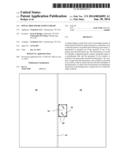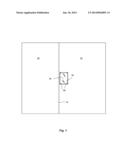Patent application title: Spinal Procedure Patient Drape
Inventors:
Scott D. Hodges (Oultewah, TN, US)
Christopher B. Young (Chattanooga, TN, US)
Assignees:
Variamed, LLC
IPC8 Class: AA61B1908FI
USPC Class:
128853
Class name: Body protecting or restraining devices for patients or infants (e.g., shields, immobilizers) drapes fenestrated
Publication date: 2014-01-30
Patent application number: 20140026895
Abstract:
A surgical drape is made from a pair of rectangular panels of drape
material which are interconnected at a separation zone so that the panels
to be pulled apart following a procedure. A fenestration is punched out
of the material of one of the panels, near the perforated zone. The
fenestration is covered by a flexible, transparent plastic window,
preferably made of a polyethylene film and the perimeter of the window is
bonded to the drape panel around the fenestration. The window is larger
than the fenestration, and is folded or gusseted at its corners so that
its center can rise well above the plane of the fenestration, in order to
provide clearance for instruments which may be protruding from a surgical
site over which the drape is placed.Claims:
1. A patient drape for protecting an open site during a surgical
operation, said drape comprising a first fabric panel, a second fabric
panel joined to the first fabric panel along a separation zone, a
fenestration formed in one of the panels for providing visual access to
said open site, a transparent window secured to one of the panels around
said fenestration, said window being substantially expansible, out of
plane in which the fenestration lies, to provide clearance for
instrumentation present at the site.
2. The invention of claim 1, wherein gussets are formed at the corners of the window to enhance its expansibility.
3. The invention of claim 1, wherein the window is substantially larger in area than said fenestration.
4. The invention of claim 1, wherein the window is made of a polyethylene film.
5. The invention of claim 1, wherein the fenestration has a maximum dimension, and the window can expand to a height at least 20% as large as said maximum dimension.
Description:
[0001] This application claims benefit of provisional patent application
61/586473, filed Jan. 13, 2012.
BACKGROUND OF THE INVENTION
[0002] This invention relates to a sterile patient drape for surgical operations, especially spinal procedures.
[0003] During surgery, a "sterile field" is defined around the patient. The sterile field does not extend to the floor, but begins a specified distance above the floor. Anything outside or below the sterile field is considered unsterile and may not be brought into or through the sterile field. If a patient drape has a portion which hangs below the sterile field, the drape cannot removed by lifting it without contaminating the sterile field. Conventional drapes are difficult to remove without lifting at least a portion of the drape.
[0004] A drape which can be removed without lifting reduces the opportunity for sterile field contamination and the risks, costs and delays which ensue.
[0005] During spinal operations, it is sometimes necessary to do imaging of the surgical site after an incision has been made, perhaps with some instrument(s) protruding from the incision. A patient drape having a transparent window with vertical expansibility to accommodate such instrument(s) would prevent contamination of the site, while providing a clear view of the site during the imaging procedure.
SUMMARY OF THE INVENTION
[0006] An object of the invention is to provide a simple and inexpensive yet versatile surgical drape that minimizes the potential for sterility breach, by providing a tear-away design.
[0007] Another object is to provide a drape which can be placed over a patient during spinal surgery during a medical imaging procedure, to provide a clear view of the surgical site, and to provide clearance for instruments which may be protruding from the surgical site.
[0008] These and other objects are attained by a surgical drape at shown in the accompanying drawings and described below.
BRIEF DESCRIPTION OF THE DRAWINGS
[0009] In the accompanying drawings,
[0010] FIG. 1 is a top plan view of a surgical drape embodying the invention
DESCRIPTION OF THE PREFERRED EMBODIMENT
[0011] A surgical drape embodying the invention, as shown in FIG. 1, comprises a pair of preferably rectangular panels 10, 12 of drape material which are interconnected at a separation zone 14, preferably by adhesive tape or by gluing. The glue or adhesive is selected so as to allow the panels to be pulled apart following a procedure. Alternatively, the panels could be formed from a single piece of drape material, and the separation zone could be a line of perforations along which the panels could be torn apart.
[0012] In the preferred form of the invention, a window or fenestration 16 is punched out of the material of one of the panels, near the separation zone 14.
[0013] While the size of the drape and of the fenestration is not critical and may be varied, for purposes of illustration, the presently preferred drape, shown in FIG. 1, has a size of about 72''×84'' (1829 mm×2134 mm); its fenestration measures about 8''×12'' (203 mm×305 mm).
[0014] The fenestration 16 is covered by a flexible, transparent plastic window 18, preferably made of a polyethylene film. The perimeter of the window, which is substantially larger than the fenestration, is bonded to the drape panel 12 around the fenestration.
[0015] The window is folded to form gussets 20 at its corners, so that the center of the window can rise well above the plane of the fenestration, in order to provide clearance for instruments which may be in place, protruding from the surgical site. The window's gusseted construction enables it to expand vertically about four inches (103 mm), which is sufficient to clear most surgical instruments which might be placed in a spinal site. The expansion height of the window may be varied if desired, as long as substantial room exists for anticipated instrumentation. At a minimum, the expanded height should be at least 20% of the maximum dimension of the fenestration.
[0016] In use, the drape is placed over the patient and is aligned so that the surgical site is visible through the fenestration. An imaging procedure such as a CAT scan can then be performed, with the drape protecting the site from contamination. Because the window can expand vertically, the drape can lie flat against the patient, even is an instrument is protruding from the site.
[0017] Following the imaging procedure, the drape may be removed by pulling the two panels apart at the separation zone (i.e., along the glue, tape or perforation line) and removing the pieces laterally, from either side of the patient. This avoids having to pull the drape over the patient, so the drape can be kept the prescribed minimum distance from the floor as it is removed.
[0018] Since the invention is subject to modifications and variations, it is intended that the foregoing description and the accompanying drawings shall be interpreted as only illustrative of the invention defined by the claims below.
User Contributions:
Comment about this patent or add new information about this topic:
| People who visited this patent also read: | |
| Patent application number | Title |
|---|---|
| 20190023533 | ELEVATOR GUIDE RAIL ATTACHMENT CLIP |
| 20190023532 | SAFETY DEVICE, ELEVATOR SAFETY SYSTEM AND ELEVATOR SYSTEM |
| 20190023531 | ARRANGEMENT FOR RELEASING THE OPERATING BRAKE OF AN ELEVATOR |
| 20190023530 | DEVICE AND METHOD FOR THE EVACUATION OF BUILDINGS |
| 20190023529 | SYSTEM AND METHOD FOR MANAGING AND MONITORING LIFTING SYSTEMS AND BUILDING FACILITIES |


